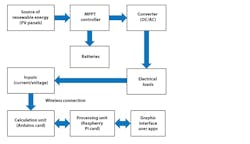Members can download this article in PDF format.
What you'll learn:
- Benefits of smart energy.
- Main methods used to create smart energy.
- Managing energy in a smart home.
Smart energy is the mode of using various methods and devices for energy efficiency.1 It focuses on powerful and sustainable renewable-energy sources that will benefit outstanding eco-friendliness with greater focus while lowering costs.
Smart energy brings a number of benefits to the table, including:
- Load management: Running everything in a home electric system isn’t very efficient. Turning off circuits that aren’t being used leads to better energy efficiency and will save a bit of money over time. Users can automate this process with most smart energy systems. Turn off everything you won't be using while sleeping, and then turn them back on in the morning.
- Smart energy systems: These are designed to help users to be as energy efficient as possible. This includes accounting for peak time of use rates, when most utilities charge more for electricity during hours of high demand. Smart energy can help users find the lowest cost times to charge your electric vehicle, run the dishwasher, or even make dinner.
- Solar optimization: If users have solar panels with a solar battery, a smart energy system will them get the most out of their electricity production. Solar batteries essentially provide a reservoir of energy that can be used to store and remove energy as needed. Smart energy systems will work with the battery by pulling energy from storage batteries and pushing it to wherever it will be needed the most and when it's most cost-effective to do so. Charging your electric vehicle (EV) or running your air conditioner off solar may lead to much lower costs than buying energy from the grid.
- Monitor energy consumption: Smart energy systems will monitor energy consumption and provide real-time data on how much electricity is being used at the circuit level. This will enable a visual representation of the quantity of energy being consumed and where users may be able to cut back to save money. Users also can acquire historical data showing a visual of energy usage over time.
Smart Energy Techniques
The following are some of the more popular methods for smart energy implementation:
Geothermal energy2
Energy from the heat inside the earth can be used for heating or electricity generation. E2E Energy Solutions is announcing a first-of-its-kind pilot project that’s geared to power and heat the community of Rainbow Lake in Alberta. By 2028, only geothermal renewable-energy sources will be used. E2E has a patent-pending system known as Enhanced Geothermal Reservoir Recovery System (EGRRS).
Hydroelectric energy3
Energy from the water flow in rivers, dams, or waterfalls can be used to produce electricity. Hydropower, a.k.a. hydroelectric power, is a renewable source of energy that can generate power by using a dam or divergence structure to change the natural flow of a river or other body of water.
Hydropower depends on the endless recharging system of a water cycle that will produce electricity. The energy available from flowing water will depend on both the volume of the water flowing and the change in elevation—also called the head—from one point to another. The greater the flow and the higher the head, the more electricity will be generated.
Wind energy4
Energy from the wind can be used to power turbines or generators. This energy source is one of the fastest-growing energy sources in the world. Wind energy is a clean and renewable energy source. This source of energy offers some excellent advantages:
- Creating well paid jobs—wind-turbine service technicians are known to be one of the fastest growing U.S. jobs of the decade.
- Wind power, in the United States, enables economic growth.
- Wind power is a renewable and clean energy source.
- Wind power benefits local U.S. communities by using the extra revenue for school budgets, reducing the tax burden on homeowners and addressing local infrastructure projects.
- Wind power is cost-effective.
- Wind turbines work in different settings as agricultural and multi-use working landscapes, and it’s easily integrated into rural/remote areas where good wind resources are found.
Solar energy5
Energy from the sun can be converted into electricity or heat. An individual photovoltaic (PV) cell is typically small, producing about 1 or 2 W of power. Solar cells consist of different semiconductor materials and are typically less than the thickness of four human hairs.
The output power of PV cells can be boosted by connecting them together in chains to form larger units known as modules or panels. The modules are able to be used individually, or many can be connected to form arrays. It’s possible to connect one or many arrays to the electrical grid as part of a complete PV system.
Creating a Smart Home
The definition of a smart home is a house with many interconnected devices.6 It will respond to residents with comfort while helping them to manage and control the use of their green energy resources.
The smart home leverages management software that employs communication and computer technology to help reduce energy consumption that centralizes many essential controls in a building, such as heating, lighting, cooling, and energy management (see figure).
A smart energy management algorithm enables a system that blends the main grid energy source with a local energy source while employing algorithms that are applied in an Arduino printed-circuit card.
The choice to use energy from the main grid or from local energy sources comes down to having enough local green energy resources or green sources produced in the home (local solar energy produced from PV panels on the roof of the house). The system makes decisions depending on the voltage state of a battery. In this example, we can assume the use of a 12-V battery with a capacity of 240 Ah.
This proposed smart home system helps to promote low-cost Internet of Things (IoT) solutions for smart home energy management within the conditions of prudent smart cities and villages.
References
1. “What is Smart Energy?,” Smart Energy.
2. “Pilot project aims to power small Canadian town entirely with geothermal energy,” Renewable Energy World, Dec. 14, 2023.
3. “How Hydropower Works, Office of Energy Efficiency & Renewable Energy,” Energy.gov.
4. “Advantages and Challenges of Wind Energy,” Wind Energy Technologies Office, Energy.gov.
5. “Solar Photovoltaic Technology Basics,” Office of Energy & Renewable Energy, Energy.gov.
6. “New Smart Home’s energy management system design and implementation for frugal smart cities,” Laraki Mehdi, Yassine Ouallou, Oussa Mohamed, Aawatif Hayar, 2018 International Workshop on Architectures for Future Mobile Computing and Internet of Things.


